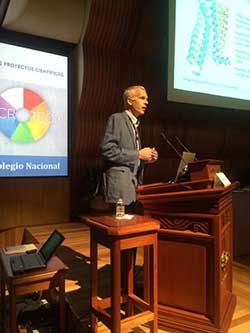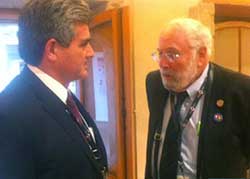Momentum Gathers Towards a Mexican Light Source
Armando Antillón, José Jiménez and Matías Moreno

Poster for El Colegio Nacional Meeting

Prof. Brian Kobilka at El Colegio Nacional Meeting, June 23-24th, 2015.

Prof. Herman Winick with Dr. Armando Antillón, a meeting co-organizer from Universidad Nacional Autónoma de México, at El Colegio Nacional, June 23-24th, 2015.
Mexico is the only large economy in the world that lacks a Synchrotron Light Source. This, however, might change soon. Indeed, ever since the government of Morelos — a tiny and beautiful state south of Mexico City — committed itself to support such a facility by funding a Strategic Plan to Build and Operate a Synchrotron in Morelos, favorable winds have been blowing for the supporters of this idea. Funding is actually a joint one; half comes from Conacyt (Consejo Nacional de Ciencia y Tecnología) Mexico’s science and technology federal funding agency. The grant was awarded to the Physics Institute at UNAM (National Autonomous University of Mexico). But other institutions also play an important role: Cinvestav, the UAM (Autonomous Metropolitan University), the University of Guanajuato and the Instituto for Physical Sciences at Morelos.
El Colegio Nacional is an emblematic national institution created by a presidential decree in 1943 and its members are the country's foremost artists and scientists. The main objective of El Colegio Nacional is the diffusion of high level culture in the country. The promoters of the Mexican synchrotron choose this institution to inform the nation of the advances made in this Project. With the help of a member of El Colegio Nacional, Dr. Octavio Novaro, a conference took place on June 23rd and 24th of this year with the objective of giving an opportunity to the academic and political sectors to exchange ideas on the feasibility of creating a facility of such magnitude, knowing that it would be the largest scientific and technological center for innovation science and technology in Mexico. Attendees from the political side included, among others, Dr. Enrique Cabrero Director of Conacyt, Dr. Jorge Flores, Coordinator of the Science Advisory Council of the Presidency of the Republic, a co-organizer of the meeting. Senator Luz María Beristain, an enthusiastic politician, also attended.
The international participants were exceptionally receptive and skillfully addressed the objectives of the meeting. The attendees were Professors Brian Kobilka and Herman Winick from Stanford, Roger Falcone from Berkeley, José Roque from LNLS, Caterina Biscari and Miguel Angel García from ALBA and Edward Mitchell from ESRF.
The sessions were broadcast live by El Colegio National and the national press was also present at the event.
This event had the major success of convincing a large sector of the academic world. After the meeting, many who had previously been skeptics became supporters of the Project. The conference also opened the doors of the Federal Congress.
More recently, the 5th Mexican Synchrotron Radiation Users Meeting took pace in Morelos’ State capital, Cuernavaca, on August 12th to 14th. The number of participants has increased since the first meeting. This time there were 60 contributions from 104 participants who came from half of the Mexican States. Plenary talks from distinguished scientists were given: Harald Reichert, ESRF, Mingh Shi and Thorsten Schmitt, PSI in Switzerland, Vivian Stojanoff, Brookhaven National Laboratory, and John Rehr, Washington University.
The governor of Morelos State, Graco Ramírez renewed his support for the MLS at the opening ceremony and spent time with students and researchers.
One relevant outcome of El Colegio Nacional synchrotron meeting was the awareness it created among a small, but influential, members of Congress and other politicians. In particular, in the Senate of the Mexican Republic, momentum is gathering to promote funding and to organize an official Senate Forum on the subject of a Mexican Synchrotron Light Source. The latter could take place as soon as this September.

5th Mexican Radiation Users Meeting. Cuernavaca, August 12-14th, 2015.
Armando Antillón, Josë Jiménez and Matías Moreno are members of the group working in the Conacyt-Morelos State project, Strategic Plan for the construction and operation of a synchrotron in Morelos. A. Antillón is in the Institute of Physical Sciences at UNAM-Morelos and is coordinating the conceptual design of the light source; J. Jiménez is in the Institute of Nuclear Sciences at UNAM-Mexico City and has a great experience working on synchrotron light sources in other countries, and M. Moreno, a high energy physicist, is in the Institute of Physics at UNAM-Mexico City and is the leader of the project.
Disclaimer - The articles and opinion pieces found in this issue of the APS Forum on International Physics Newsletter are not peer refereed and represent solely the views of the authors and not necessarily the views of the APS.
